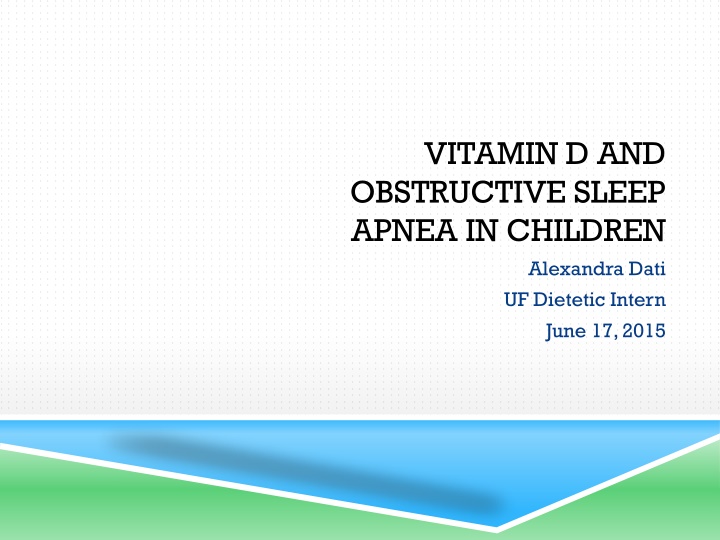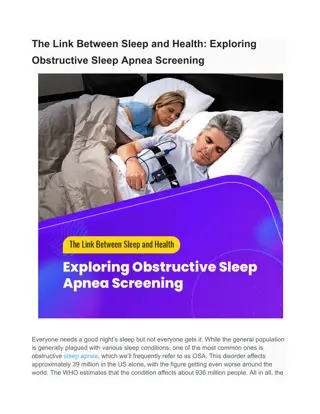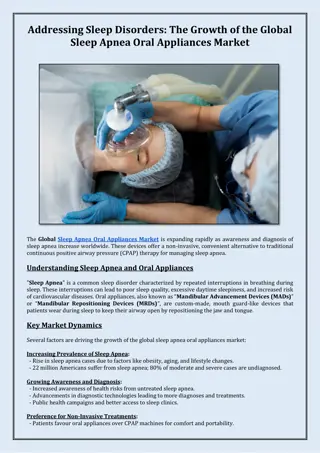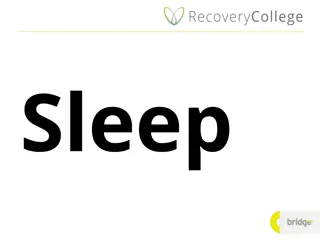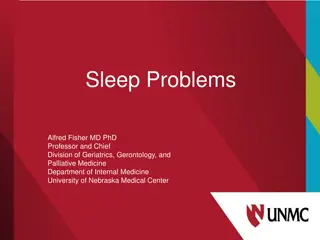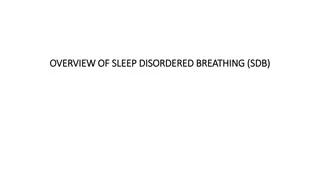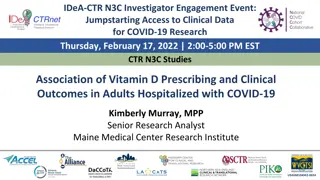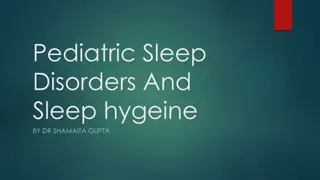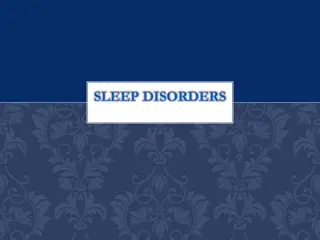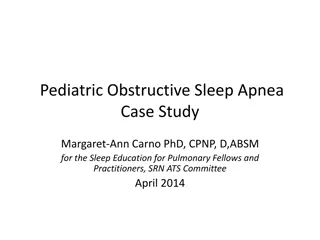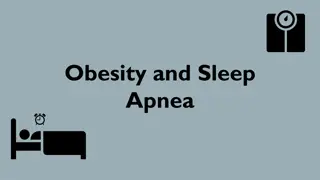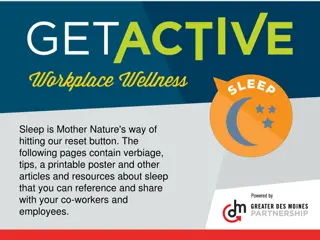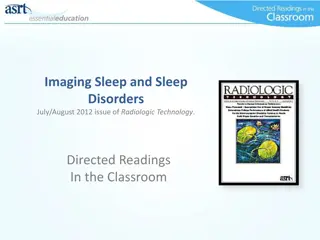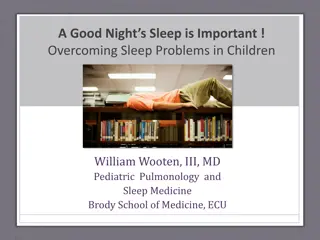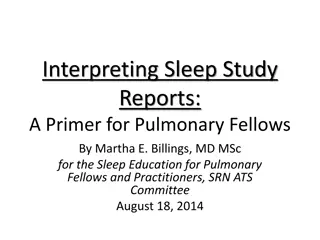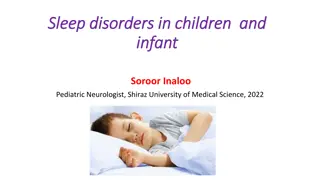Vitamin D and Obstructive Sleep Apnea in Children
This presentation delves into the relationship between vitamin D levels and obstructive sleep apnea in children. It covers the basics of sleep apnea, its impact on children, and the implications for clinical practice. Explore the objectives, symptoms, diagnosis, prevalence, and pathophysiology associated with obstructive sleep apnea.
Download Presentation

Please find below an Image/Link to download the presentation.
The content on the website is provided AS IS for your information and personal use only. It may not be sold, licensed, or shared on other websites without obtaining consent from the author.If you encounter any issues during the download, it is possible that the publisher has removed the file from their server.
You are allowed to download the files provided on this website for personal or commercial use, subject to the condition that they are used lawfully. All files are the property of their respective owners.
The content on the website is provided AS IS for your information and personal use only. It may not be sold, licensed, or shared on other websites without obtaining consent from the author.
E N D
Presentation Transcript
VITAMIN D AND OBSTRUCTIVE SLEEP APNEA IN CHILDREN Alexandra Dati UF Dietetic Intern June 17, 2015
OUTLINE Objectives Review of sleep apnea Sleep apnea in children Vitamin D and sleep apnea Implications for practice
OBJECTIVES Obtain basic knowledge of obstructive sleep apnea Understand obstructive sleep apnea in children Recognize relationship of vitamin D and obstructive sleep apnea Learn clinical approaches to vitamin D and obstructive sleep apnea
WHAT IS IT? A sleep disorder that is marked by pauses in breathing of ten seconds or more during sleep, and causes unrestful sleep Results in oxygen desaturation and increased carbon dioxide Need for increased respiratory effort Cortical or subcortical arousals Sleeper will typically drift back to sleep and may not be aware of arousals
PATHOPHYSIOLOGY The tongue falls back against the soft palate, the soft palate and uvula fall back against the throat, effectively closing the airway Result: when the sleeper expands the chest to inhale, no air enters the lungs Small upper airway Small lower face Small mouth Large tongue Tonsil/adenoid enlargement Increased pharyngeal fat pads Increased in Back sleepers Middle-age Overweight Male The Nemours Foundation/KidsHealth Habib M henni/Wikimedia Commons
OBSTRUCTIVE SLEEP APNEA Symptoms Diagnosis Snoring Fatigue Daytime sleepiness Restless sleep Morning headaches, dry mouth, or sore throat Medical and family histories Physical exam Sleep study results
PREVALENCE Affects approximately 12 million Americans Mild, moderate, or severe How many times a person pauses their breathing or has lower airflow per hour How low a person s oxygen level in their blood drops during those times The amount of sleepiness a person feels during the day
OBSTRUCTIVE SLEEP APNEA IN CHILDREN
PREVALENCE Children at higher risk include: Craniofacial syndromes Dwarfism Cerebral palsy Neuromuscular disorders Spina Bifida Sickle cell disease Trisomy 21 Seasonal allergies Asthma Small lower jaw Large tongue Large tonsils and adenoids Afro Caribbean race Obesity Estimated 1%-5% of children have OSA Peak prevalence 2-8 years Reduced airway caliber vs. increased upper airway collapsibility Multiplicity of causative factors coexist in children with OSA
PATHOPHYSIOLOGICAL FACTORS INVOLVED IN PEDIATRIC OSA
OBESITY AND OSA Each 1 kg/m2 increment in BMI above the 50th percentile is associated with an increased risk for OSA by 12% 45% if obese children with OSA also have evidence of adenotonsillar hypertrophy Reciprocal interaction OSA may be contributing to pathogenesis of obesity Hunger cues Physical activity
SYMPTOMS MUCH MORE SCARCE THAN IN ADULTS Nighttime Daytime Snoring Excessive sweating Bed wetting Restless sleep Mouth breathing Gasping Labored breathing Hyperextension of neck Difficulty concentrating Behavioral and mood problems Morning headaches Excessive daytime sleepiness Failure to thrive
TREATMENT Adenotonsillectomy For children with adenotonsillar hypertrophy Residual OSA may still exist CPAP/BIPAP Adherence can be challenging
VITAMIN D Fat-soluble vitamin Synthesized by body and found in food and supplements Biologically inactive goes to liver and kidneys for processing Multiple functions in the body Requirements Infants: 400 IUs Children & teens: 600 IUs 25-Hydroxyvitamin D > 20 ng/mL > 30 ng/mL
LOW VITAMIN D Deficiency Inadequate intake or sun exposure Fat malabsorptive disorder Impaired liver or kidney hydroxylation Increases in frequency and severity of metabolic dysfunction, cardiovascular disease risk factors, and incidence of upper respiratory tract infections Recent preliminary study suggested that children at risk for adenotonsillectomy may exhibit lower serum 25- hydroxyvitamin D concentrations
http://ods.od.nih.gov/factsheets/VitaminD-HealthProfessional/http://ods.od.nih.gov/factsheets/VitaminD-HealthProfessional/
Kheirandish-Gozel, Peris, Gozal, 2015 VITAMIN D LEVELS AND OBSTRUCTIVE SLEEP APNEA IN CHILDREN
METHODS 176 children underwent sleep study Monitored for apnea events Plasma Assays CRP, serum lipid levels, insulin levels, glucose levles 25-hydroxyvitamin D
RESULTS Subdivision of children Presence or absence of obesity and OSA African American children had lower vitamin D levels than Caucasian children No differences according to age or gender Children with OSA had higher total and and LDL cholesterol and lower HDL cholesterol Severity of OSA were not significantly different in obese and non-obese children with OSA.
RESULTS Obese children without OSA had lower vitamin D levels than non-obese children without OSA Non-obese children with OSA also exhibited lower vitamin D levels compared to non-obese controls Obese children with OSA demonstrated the lowest 25- hydroxyvitamin D levels Low vitamin D levels are associated with insulin resistance but not dyslipidemia
CONCLUSIONS Low vitamin D levels are associated with adverse outcomes in systemic inflammatory diseases Vitamin D levels are reduced in pediatric OSA, particularly in obese children Vitamin D levels account for a proportion of the variance in insulin resistance pediatric OSA The short-term and long-term significance of reduced 25- hydroxyvitamin D in pediatric OSA remains undefined
WHAT WE CAN DO Obese children with OSA are may consume an unbalanced diet which may lead to reduced intake of vitamins Check vitamin levels Treat as necessary Encourage vitamin D Vitamin D rich foods Sun exposure Vitamin D supplementation
HEALTHY LIFESTYLE Promote healthy diet Physical activity Limit screen time Portion control
VITAMIN D SUPPLEMENTATION Over the counter Relatively inexpensive
REFERENCES National Institutes of Health. Obstructive Sleep Apnea. Pub Med Health Web site. Available at http://www.ncbi.nlm.nih.gov/pubmedhealth/PMHT0024431/. N.D. American Sleep Apnea Association. Obstructive Sleep Apnea. ASAA Web site. Available at http://www.sleepapnea.org/learn/sleep-apnea/obstructive-sleep-apnea.html. N.D. Tan HL, Gozal D, Kheirandish-Gozal L. Obstructive sleep apnea in children: a critical update. Nature and Science of Sleep. 2013;5:109-123. Schmidt-Nowara W. Patient Information:Sleep Apnea in Adults (Basic and Beyond). UpToDate Web site. Available at http://www.uptodate.com/contents/sleep-apnea-in-adults-beyond-the-basics. Updated July 2, 2014. National Institutes of Health. How is Sleep Apnea Diagnosed? National Heart Lung and Blood Web site. Available at http://www.nhlbi.nih.gov/health/health-topics/topics/sleepapnea/diagnosis. Published July 10, 2012. Eisenber JM. Treating Sleep Apnea. Pub Med Health Web site. Available at http://www.ncbi.nlm.nih.gov/pubmedhealth/PMH0016158/. Published August 8, 2011. American Sleep Apnea Association. Children s Sleep Apnea. ASAA Web site. Available athttp://www.sleepapnea.org/treat/childrens-sleep-apnea.html. N.D. US National Library of Medicine. Vitamin D. MedlinePlus Web site. Available at http://www.nlm.nih.gov/medlineplus/vitamind.html. Updated May 19, 2015. Pazirandeh S, Burns DL. Overview of Vitamin D. UpToDate Web site. Available at http://www.uptodate.com/contents/overview-of-vitamin-d. Updated May 8, 2014. Kheirandish-Gozel L, Peris E, Gozal D. Vitamin D Levels and Obstructive Sleep Apnea in Children. Sleep Medicine. 2014;15(4):459-463.
